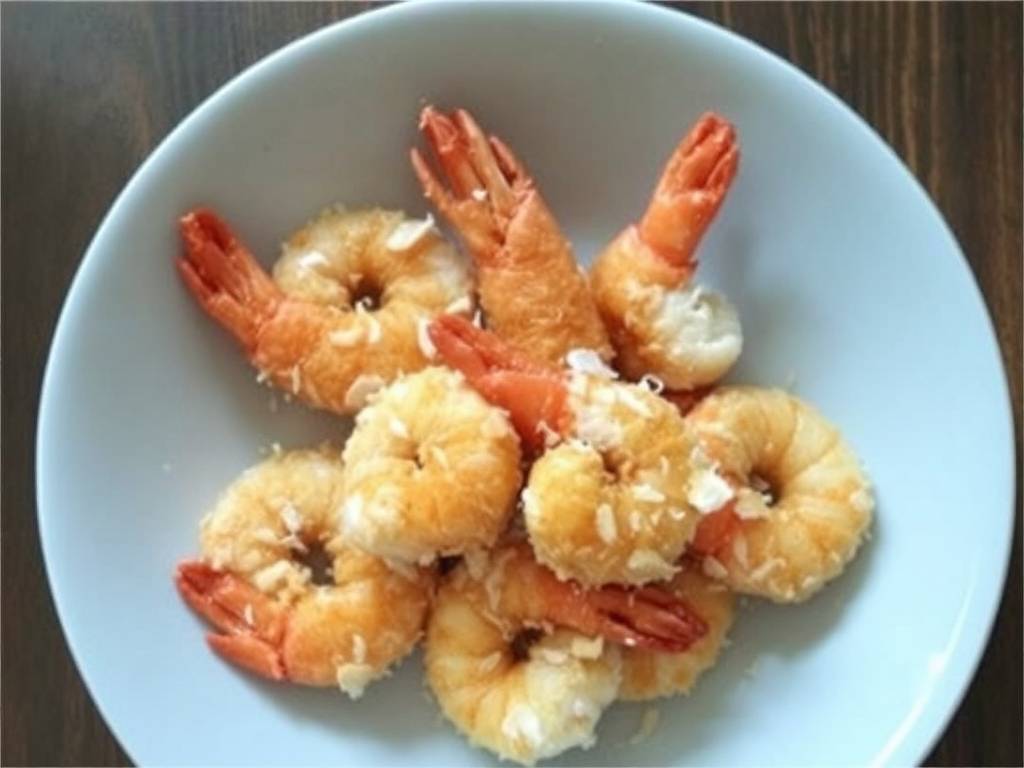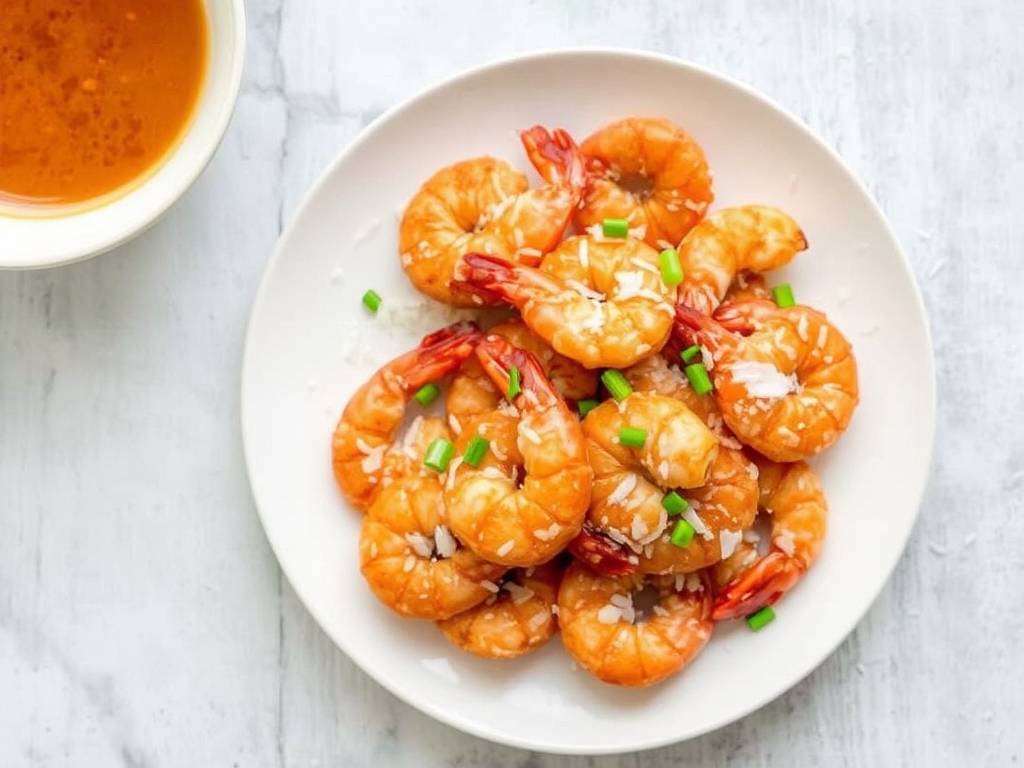Crispy Coconut Shrimp Delight: Your Ultimate Guide to Perfect Fried Shrimp with Coconut Flakes
There's something magical about the combination of succulent shrimp and sweet, toasted coconut. If you've ever wondered how to create that perfect restaurant-quality fried shrimp with coconut flakes at home, you've come to the right place. This comprehensive guide will walk you through every step, from selecting ingredients to mastering frying techniques, ensuring you achieve golden-brown perfection every time.
Many home cooks hesitate to make coconut shrimp, fearing complicated steps or unsatisfactory results. But I'm here to tell you that creating delicious coconut crusted shrimp is easier than you think! This recipe solves common problems like soggy coating, uneven cooking, and flavor imbalance. We'll cover everything you need to know about making the best coconut fried shrimp, including preparation tips, cooking methods, and serving suggestions.

Let's start with what you'll need. For the coconut shrimp batter, gather one pound of large shrimp (16-20 count), peeled and deveined but with tails intact. The tails make perfect handles for dipping! You'll need one cup of all-purpose flour, two large eggs, one cup of panko breadcrumbs, and one cup of sweetened coconut flakes. For optimal flavor, include half a teaspoon of garlic powder, quarter teaspoon of paprika, and salt and pepper to taste. The coconut flakes are crucial - they create that signature crispy coconut coating that makes this dish so special.
Preparation begins with setting up your breading station - this is the secret to perfectly coated shrimp. Use three shallow bowls: place flour in the first bowl, beaten eggs in the second, and a mixture of panko breadcrumbs and coconut flakes in the third. The panko helps create an extra crispy texture while the coconut provides sweetness and tropical flavor. This triple-coating method ensures your coconut crusted shrimp will have that delightful crunch we all love.
Now, let's talk about the shrimp preparation - this step makes all the difference in achieving professional results. Pat the shrimp completely dry with paper towels; this helps the coating adhere properly. Hold each shrimp by the tail and dredge it in flour, shaking off any excess. Next, dip it in the egg wash, allowing excess to drip off. Finally, press the shrimp firmly into the coconut-panko mixture, ensuring an even, generous coating. Place the breaded shrimp on a parchment-lined baking sheet as you work. This organized approach prevents the coating from becoming clumpy or uneven.

When it comes to cooking methods, you have options depending on your preference and equipment. For traditional deep frying, heat about three inches of vegetable oil in a heavy-bottomed pot to 350°F (175°C). The oil temperature is critical - too hot and the coconut burns before the shrimp cooks; too cool and the coating becomes greasy. Fry the shrimp in batches for 2-3 minutes until golden brown, being careful not to overcrowd the pot. This method creates the crispiest coconut fried shrimp with that signature crunch.
If you prefer a healthier alternative, baked coconut shrimp works wonderfully too. Preheat your oven to 425°F (220°C) and place the breaded shrimp on a wire rack set over a baking sheet. Lightly spray the shrimp with cooking oil and bake for 10-15 minutes, flipping halfway through. While the texture differs slightly from fried, this method still delivers delicious results with less oil. The baked version is perfect for those watching their calorie intake but still craving that coconut shrimp flavor.
The dipping sauce can elevate your coconut shrimp from great to extraordinary. While the classic orange marmalade sauce is always popular, consider experimenting with different flavors. A simple spicy mango sauce combines mango puree, lime juice, and a dash of chili sauce. For a creamy option, mix Greek yogurt with honey, lime zest, and fresh mint. These sauces complement the sweet and savory profile of the coconut crusted shrimp beautifully, creating a balanced flavor experience.
Now, let's address common troubleshooting issues. If your coating falls off during frying, the oil temperature might be too low, or the shrimp weren't patted dry enough. Soggy coconut shrimp often results from overcrowding the pan or using oil that's not hot enough. For extra crispy shrimp, you can double-coat them by repeating the egg and breadcrumb steps. These simple fixes will ensure your homemade coconut shrimp turns out perfectly every time.
Serving suggestions can transform your coconut shrimp into a complete meal. Serve them as an appetizer with lemon wedges and dipping sauces, or make them the star of your main course alongside coconut rice and steamed vegetables. For a tropical twist, pair them with pineapple salsa and a fresh green salad. The versatility of coconut fried shrimp makes it suitable for casual dinners and special occasions alike.
Storage and reheating tips are essential for enjoying leftovers. Store cooked coconut shrimp in an airtight container in the refrigerator for up to three days. To reheat, avoid the microwave as it will make the coating soft. Instead, use an oven or toaster oven at 375°F (190°C) for 8-10 minutes until heated through and crispy. This method helps maintain that delightful texture that makes coconut shrimp so irresistible.
The beauty of this coconut shrimp recipe lies in its adaptability. You can customize the flavor by adding different spices to the flour mixture - try cayenne pepper for heat or curry powder for an exotic twist. For a gluten-free version, use almond flour and gluten-free breadcrumbs. The basic technique remains the same, allowing you to create variations that suit your dietary needs and flavor preferences.
Making coconut shrimp at home not only saves money compared to restaurant prices but also allows you to control ingredient quality. You can source sustainable shrimp, use organic coconut flakes, and adjust seasoning to your taste. This homemade approach results in a superior product that's both delicious and prepared according to your standards.
As you become comfortable with the basic recipe, don't hesitate to experiment. Try adding finely chopped nuts to the coating mixture, or incorporate different types of shredded coconut. Each variation creates a unique texture and flavor profile, keeping this classic dish exciting and new. The process of making coconut fried shrimp should be enjoyable and creative - don't be afraid to make it your own!
Remember, the key to perfect coconut shrimp lies in attention to detail: proper drying of shrimp, maintaining correct oil temperature, and not overcrowding the cooking vessel. With practice, you'll develop an instinct for timing and technique that will make this recipe second nature. Soon, you'll be impressing family and friends with your coconut shrimp expertise, possibly even creating your own signature version of this beloved dish.
From preparation to plating, every step contributes to the final result. Take your time, enjoy the process, and don't get discouraged by minor setbacks. Even professional chefs continuously refine their techniques. The journey to mastering coconut shrimp is part of the pleasure of cooking - each batch brings you closer to perfection while providing a delicious meal along the way.
So gather your ingredients, set up your station, and embark on your coconut shrimp adventure. With this comprehensive guide, you have all the information needed to create exceptional fried shrimp with coconut flakes that will rival any restaurant version. Happy cooking, and may your coconut shrimp always be crispy, golden, and utterly delicious!






发表评论